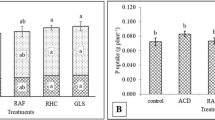Abstract
Fifteen-day-old variety NA 56-79 sugar cane seedlings were inoculated with Azospirillum brasilense and Glomus intrarradix. This article aims at examining changes in sugar cane root seedlings inoculated with Glomus intrarradix and Azospirillum brasilense, the increase in microbial biomass and the acetylene reduction process as well. The internal root colonization was studied 20 days after inoculation using scanning and a transmission electron microscope. Both microorganisms entered the sugar cane root through the emergent lateral roots. The microorganisms were capable of coexisting both intra and intercellularly, producing changes in the cell wall, thus allowing colonization and interaction between the organisms. These changes increased the number of microorganisms inside the root as well as acetylene nitrogen reduction. Sugar cane plant biomass increased with joint-inoculation. The number of endophytic microorganisms and nitrogen fixing activity increased when they were colonized by Azospirillum and Glomus together.








Similar content being viewed by others
References
Döbereiner J, Pedrosa FO (1987) Nitrogen fixing bacteria in non-legume crop plant Brock. Springer Series in Contemporary Bioscience. Science Tech Publisher, Madison, p 156
Döbereiner J (1992) History and new perspectives of diazotrophs in association with non-leguminous plants. Symbiosis 13:1–13
Lima E, Boddey RM, Döbereiner J (1987) Quantification of biological nitrogen fixation associated with sugar cane using a 15N aided nitrogen balance. Soil Biol Biochem 19:165–170
Urquiaga S, Cruz KHS, Boddey RM (1992) Contribution of nitrogen fixation to sugar cane: N15 and nitrogen balance estimate. Soil Sci Soc Am J 56:105–114
Bellone CH, Bellone SC, Pedraza RO (1995) Chitinase expression in strawberry root colonized by Azospirillum brasilense and V. A. Mycorrhiza. In: Fendrik I, Del Gallo M, Vanderleyden J, Zamaroczy M (eds) Azospirillum VI and related microorganisms, vol 37. Springer-Verlag, Heidelberg, pp 161–165
Boddey RM, Urquiaga S, Reis V, Döbereiner J (1991) Biological nitrogen fixation associated with sugar cane. Plant Soil 137:11–117
Döbereiner J, Baldani VLD, Olivares F, Reis VM (1993) Endophytic diazotrophs: the key to BNF in gramineous plants. In: Hegazi NA, Fayez M, Monib M (eds) Nitrogen fixation with non-legumes. Cairo University, Giza, pp 395–408
Döbereiner J, VlD Baldani, Reis VM (1995) Endophytic occurrence of diazotrophs bacteria in non-leguminous crops. In: Fendrik et al (eds) Azospirillum VI and related microorganims. Springer-Verlag, Heidelberg, pp 3–14
Hurek T, Reinhold-Hurek B, Turner GL, Bergersen FJ (1994) Augmented rates of respiration and efficient nitrogen fixation at nanomolar concentrations of dissolved O2 in hyperinduced Azoarcus sp. strain BH72. J Bacteriol 176:4726–4733
James EK, Reis VM, Olivares FL, Baldani JI, Döbereiner J (1994) Infection of sugar cane by nitrogen fixing bacteria. J Exp Bot 45:757–766
Olivares FL, Baldani VLD, Reis VM, Baldani JI, Döbereiner J (1996) Occurrence of the endophytic diazotrophs Herbaspirillum spp. in roots stem and leaves predominantly of gramineae. Biol Fertil Soils 21:197–200
Pedraza RO, Diaz Ricci JC (2003) Genetic stability of Azospirillum brasilense after passing through the root interior of sugar cane. Symbiosis 34:69–83
Phyllips JM, Hayman DS (1970) Improved procedures for clearing and staining parasitic and vesicular–arbuscular mycorrhizae fungi for rapid assessment of infection. Trans Br Mycol Soc 55:158–161
Bellone CH (1996) Micorrización y Fijación de Nitrógeno en el Área Cañera de la Provincia de Tucumán. FAZ de la Universidad Nacional de Tucumán, Tesis, p 317
Bellone CH, Bellone SC, Pedraza RO, Monzón MA (1997) Cell colonization and infection thread in sugar cane roots by Acetobacter diazotrophicus. Soil Biol Biochem 29:965–967
Patrikin DG, Döberiner J, Jain DK (1983) Sites and processes of association between diazotrophs and grasses. Can J Microbiol 29:900–915
Reis VM, Olivares FL, Döbereiner J (1994) Improved methodology for isolation of Acetobacter diazotrophicus and confirmation of its endophytic habitat. World J Microbiol Biotechnol 10:101–104
Bellone CH (1983) Actividad celulolítica de tejidos no diferenciados de caña de azúcar inoculadas con dos especies de Azospirillum. Rev Agron Noroeste Argent XIX:4–8
Bellone CH, Carrizo de Bellone S (1993) Nitrogenase, cellulase activity in sugar cane roots inoculated together with va mycorrhiza and nitrogen-fixing bacteria. In: Hegazy N, Fayez M, Monib M (eds) Nitrogen fixation with non-legumes. The American University in Cairo Press, Cairo, pp 69–75
Bellone CH (2002) Especies de endomicorrizas en caña de azúcar en Tucumán. Manejo de sistemas microbianos para optimizar la producción agrícola y silvopastoril en algunas áreas del NOA, pp 117–121
Paula MA, Reis VM, Döbereiner J (1991) Interaction of Glomus clarum with Acetobacter diazotrophicus in infections of sweet potato (Iponema batata), sugar cane (Saccharum spp.) and sweet sorghum (Sorghum vulgare). Biol Fertil Soil 11:111–115
Döbereiner J, Baldani DVL, Baldani JI (1995) Como isolar e identificar bacterias diazotroficas de plantas năo-leguminosas. MAARA EMBRAPA CNPAB, Brasilia, p 60
Morton JM, Benny GL (1990) Revised classification of arbuscular mycorrhizal fungi (Zygomycetes): a new order, Glomales. Two new suborders, Glominiae and Gigasporinae, and two new families, Acaulosporaceae, and Gigasporaceae, with an emendation of Glomaceae. Mycotaxon 37:471–491
Shenck NC, Perez Y (1990) Manual for the identification of VA mycorrhizal fungi, 3rd edn. Synergistic Publications, Gainesville, p 286
Hoagland DR, Arnon DL (1950) The water culture method for growing plant without soil. University of California, Berkeley, p 32
Genderman CW, Nicolson JH (1963) Spores of mycorrhizal species extracted from soil by wet sieving and decanting. Trans the Br Mycol Soc 46:235–246
Bellone CH and Monzon de Asconegui MA (1987) Electron microscopy observation of Azospirillum spp. cell within sugar cane (Saccharum spp) roots. 5th Congress International of Nitrogen Fixation. Brazil, pp 85–87
Author information
Authors and Affiliations
Corresponding author
Rights and permissions
About this article
Cite this article
Bellone, C.H., de Bellone Silvia, C. Interaction of Azospirillum brasilense and Glomus intrarradix in Sugar Cane Roots. Indian J Microbiol 52, 70–75 (2012). https://doi.org/10.1007/s12088-011-0208-0
Received:
Accepted:
Published:
Issue Date:
DOI: https://doi.org/10.1007/s12088-011-0208-0




